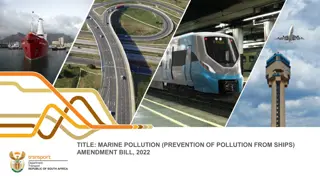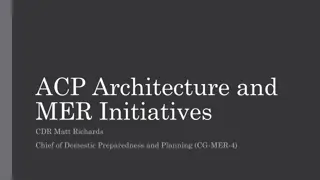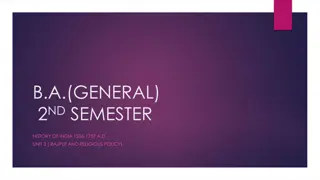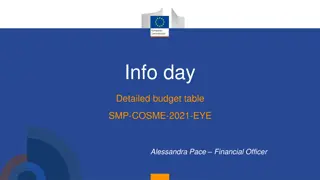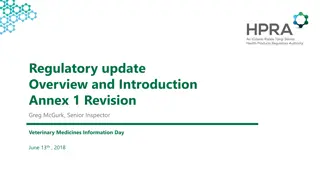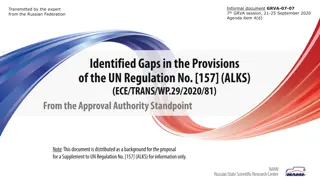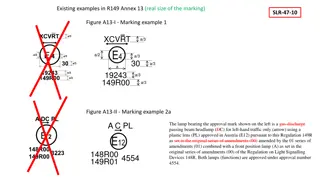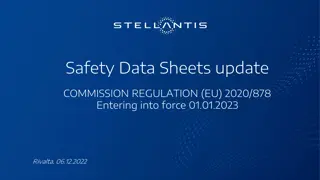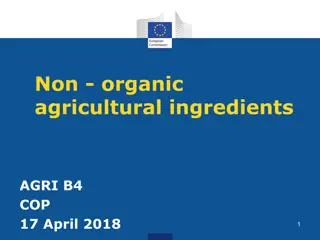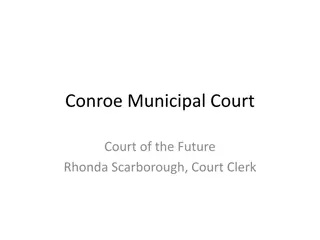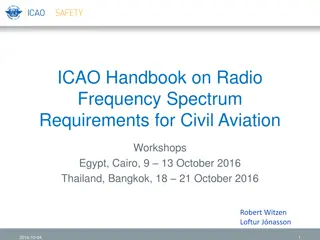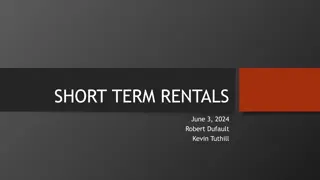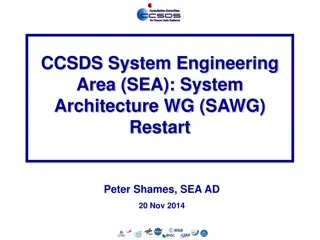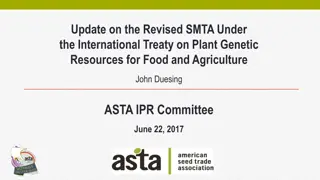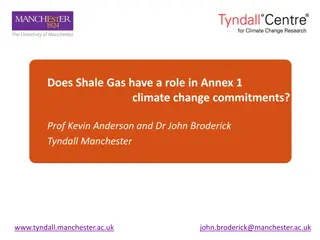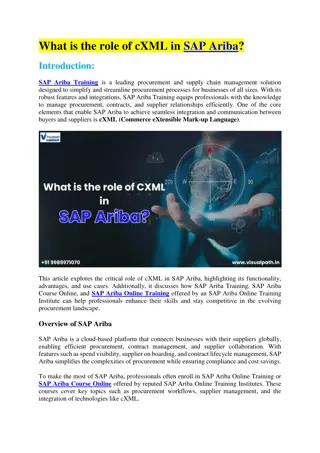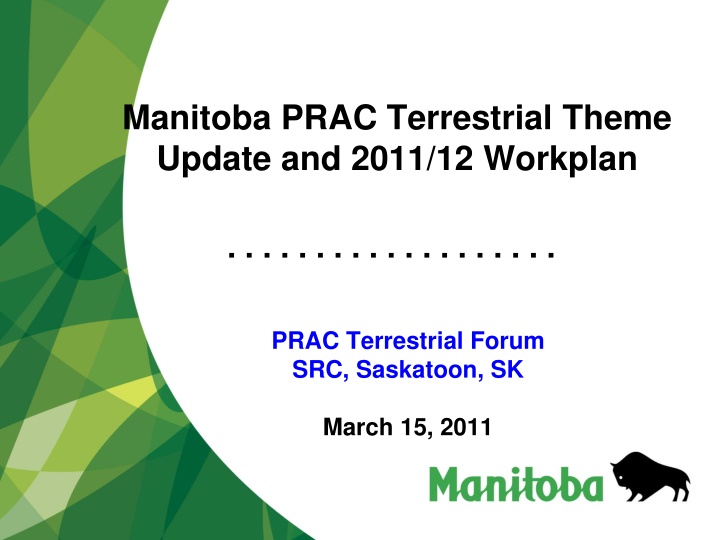
Enhancing Manitoba's Terrestrial Ecosystem Management for Climate Adaptation
Explore how Manitoba is enhancing stakeholder capacity to integrate climate change adaptation into terrestrial ecosystem management planning. Find out about the objectives, outputs, and outcomes of the PRAC Terrestrial Theme for forest and grassland adaptation in Manitoba.
Download Presentation

Please find below an Image/Link to download the presentation.
The content on the website is provided AS IS for your information and personal use only. It may not be sold, licensed, or shared on other websites without obtaining consent from the author. If you encounter any issues during the download, it is possible that the publisher has removed the file from their server.
You are allowed to download the files provided on this website for personal or commercial use, subject to the condition that they are used lawfully. All files are the property of their respective owners.
The content on the website is provided AS IS for your information and personal use only. It may not be sold, licensed, or shared on other websites without obtaining consent from the author.
E N D
Presentation Transcript
Manitoba PRAC Terrestrial Theme Update and 2011/12 Workplan . . . . . . . . . . . . . . . . . . . PRAC Terrestrial Forum SRC, Saskatoon, SK March 15, 2011
MB PRAC Terrestrial Theme Objective: Enhance the capacity of key stakeholders to integrate climate change adaptation into terrestrial (forest and grassland) ecosystem management planning and decision-making With total funding of $117,300 from NRCan matched with $60,964 cash and in-kind contributions from MB Government
Expected MB Terrestrial Theme Outputs and Outcomes TERRES- TRIAL THEME COMPO- NENT EXPECTED MB OUTPUTS/ DELIVERABLES EXPECTED OVERALL PRAC TERRESTRIAL THEME OUTPUTS EXPECTED OUTCOMES FROM PRAC ON MB POLICIES, PLANS, OPERATIONS Increased capacity for developing/enhancing MAFRI grassland/rangeland management policies and practices that adapt to climate change impacts and other factors using a risk- based decision- making framework Grasslands Ecosystem 1) Modified AB SRD assessment framework for MB grassland management application 2) Risk and vulnerability assessment of climate impacts on southern MB grasslands (case study) 3) Report on PRAC terrestrial MB recommendations- grassland, other resource management areas 1) Application of CC adaptation framework for the grassland ecosystems; 2) Case studies representing a selection of priority grassland ecosystems adaptation issues; 3) Adaptation strategies for grassland ecosystems management decision- makers; and 4) Synthesis report.
Expected MB Terrestrial Theme Outputs and Outcomes EXPECTED MB OUTPUTS/ DELIVERABLES OUTPUTS TERRES- TRIAL THEME COMPO- NENT EXPECTED OVERALL PRAC TERRESTRIAL Expected Outcomes from PRAC on MB policies, plans, operations, as a result of PRAC outputs Increased ability to develop and enhance sustainable and adaptive forestry policies and decision-making processes using a risk- based decision making framework Forest Ecosystems 1) Modified AB SRD assessment framework for MB forest management application 2) Case study on climate impacts and vulnerabilities to MB forest ecosystems 3) Report on PRAC terrestrial MB recommendations-forest, other resource management areas 1) Application of CC adaptation framework for the forest ecosystems; 2) Case studies representing a selection of priority forest ecosystems adaptation issues; 3) Adaptation strategies for forest ecosystem management decision- makers; and 4) Synthesis report.
Current Status of Work KEY ACTIVITIES STATUS OUTPUTS 1. Finalization of methodology, approach, workplan and budget and implementation of task activities On-going internal discussions between MB Planning Team (PT), Consultant and SRC, and with inter-provincial Terrestrial WG; Held MB CC Adaptation Workshop attended by 38 MB decision-makers from 4 departments Workshop Summary Report ready for posting on PRAC website 2. Information analysis in support of MB Terrestrial theme deliverables Collected information on adaptation initiatives in forestry and grassland; Further discussions with PT on planning and implementation of internal vulnerability and risk assessment for grasslands/ rangelands and forest ecosystems and mgmt. policies, & required case studies & other data collection /analysis work to support adaptive planning processes Listing of current adaptation initiatives in forestry and grassland ecosystems; High- level risk and vulnerability assessment and listing of adaptation options
Highlights of Adaptation Workshop Objectives: Assess climate impacts and vulnerabilities to MB agriculture and forestry sectors; and Demonstrate practical application of AB SRD adaptation framework to MB grassland and forest ecosystems/ sectors; Develop practical adaptation options and identify possible gaps, barriers and opportunities for integrating adaptation into existing decision-making; Generate interest and commitment readiness and resilience within the targeted areas of Conservation and MAFRI
Highlights of Adaptation Workshop (2) Key Outputs: List of current climate change adaptation related initiatives of MAFRI and CON-Forestry High-level vulnerability and risk assessment of MB grasslands and forest ecosystems; List of adaptation options for the two sectors List of possible gaps, potential barriers and opportunities for addressing risks
Highlights of Adaptation Workshop (3) Vulnerability and Risk Assessment Highlights- Breakout groups Overall medium vulnerability ranking for MB Parkland region resulting from shifting vegetation patterns starting 2020s High vulnerability and risk ratings for water regulation and wetlands Low risk rating for cattle operations
Objectives for FY 2011/12 Refine and finalize methodological framework and risk and vulnerability assessment results for grassland ecosystems in southern MB and forest ecosystems (case study area yet to be identified) ; Identify adaptation options and strategies as well as possible gaps, barriers and opportunities for integrating these into existing MAFRI s policies on rangeland management and conservation planning, and MB Forestry policies; Further engage key local decision-makers and other stakeholders to enhance their awareness and capacity in adaptation planning; and Document, synthesize and disseminate key lessons learned and best practices from risk assessment and adaptation planning for grassland/ rangeland and forest ecosystems in case study areas.
Grasslands Workplan for 2011/12 ACTIVITY EXPECTED OUTPUT TIMELINES 1. MB Grasslands case study A n assessment of climate impacts, vulnerabilities and risks for grassland ecosystems focusing on grazing systems and species at risk in southern MB A report outlining the results of the AB SRD Adaptation Framework application to MB grasslands ecosystem Apr 2011-Sep 2011 2. Risk and vulnerability assessment and adaptation planning Apr 2011-Feb 2012 3. MAFRI policy review A report targeted to grassland management decision-makers outlining adaptation strategies for grassland/rangeland policies, planning and management Sep 2011-Feb 2012
Forestry Workplan for 2011/12 ACTIVITY 1. Forest ecosystems case study EXPECTED OUTPUT An analysis evaluating the influence of climate variability impacts on forest growth to support future modeling efforts related to CC and adaptation planning; TIMELINES Apr 2011-Mar 2012 2. Forestry vulnerability assessment and adaptation planning A report outlining a working example of SRD s adaptation framework applied for a MB forestry application. Apr2011-Mar 2012 3. Forestry policy review A report identifying recommendations of existing policies to ensure impacts of climate change considered April 2011-Mar 2012
MB PRAC Terrestrial Theme Planning Team and Partners Manitoba Conservation Climate Branch: Randall Shymko and Ramon Sales Forestry Branch: Ryan Klos MAFRI Jenelle Hamblin and Tony Szumigalski (on-leave) Other MB Institutional Partners: Saskatchewan Research Council (SRC), International Institute of Sustainable, Development (IISD), University of Winnipeg and Deloitte and Touche
Key Implementation Issues Lack of sufficient resources in light of many competing priorities Dedicated staff and expertise Staff turnover Funding for research Lack of examples of start to finish projects to use as success stories


